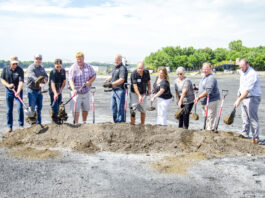by Don Steen and Kathy Tretter
Several bills recently signed into law by Indiana Governor Mike Braun signified a red letter day for Spencer County and surrounding communities.
These bills kick-start plans to convert Indiana Michigan Power (AEP) from a coal-fired electric generating plant to a small modular nuclear reactor.
Spencer County Commissioner Jim Seiler and Spencer County Councilman Steve Haaff, with assistance from South Spencer School Corporation Superintendent Brad Schneider led the charge. They lobbied local and state legislators and were able to get the job done after testifying before senate and house committees to make Senate Enrolled Act 424 (small modular nuclear reactor developmental costs), and House Enrolled Act 1007 (energy generation resources) realities.
All three men were joined last week by Alexa Schaefer, Indiana Michigan’s External Affairs Manager, to share perspectives.
While plans are still very preliminary, Schaefer explained that just one reactor would provide up to 300 megawatts — the equivalent of enough generation to power about 300,000 homes, as well as large scale industries and commercial operations.
Schaefer noted, “We’ll more than double [our output] over the next five years.”
The technology already exists — in fact it’s been in use on nuclear submarines since the 1960s.
Schaefer noted, “Small Modular Reactors (SMRs) have been used for decades in Navy ships, submitted to innumerable stresses without incident. Modern utility-scale reactors are built with a passive-fail system.”
What does that mean?
Passive Safety Systems rely less on operator action or specific mechanisms. Instead, they use natural forces like gravity, convection and evaporation to cool the reactor core automatically. This offers redundancy in the event of mechanical or human error.
SMR reactors are smaller, and generate less heat, making all cooling methods more effective. These reactors are simpler, meaning there are fewer points of potential failure and making maintenance easier.
According to Schaefer, the company has a great deal of experience in the nuclear industry.
Schneider encourages anyone with concerns to take a tour of I & M’s Cook Nuclear Plant in Bridgman, Michigan, as he did recently. “Safety is the culture at Cook. It’s been their tradition for over 50 years.”
What about waste?
The nuclear waste will be stored on-site in a dry-cask system. Schaefer remarked, “You could hug a dry-cask for 72 hours and you’d get less radiation than from a dental x-ray.” She also mentioned that storing nuclear waste is something they’ve been doing for decades.
Schneider added that nuclear waste isn’t really waste anymore as a portion can be reprocessed into usable fuel. Waste material could prove a valuable resource in the future as technology improves and demand for nuclear fuel grows.
How long would it take to build?
That’s hard to answer, as utility-scale projects of this type are still in the very early stages, at least in North America. Schaefer estimated that the Rockport Generating Station could make the full conversion by the mid-2030’s, after several years of construction. More than 1,000 workers would be involved in the construction phase, and anywhere from two to three hundred permanent jobs will need to be filled once operations begin.
Recent U.S. attempts at bringing new traditional nuclear reactors online have been faced with delays and other challenges. However, an SMR plant would not be built the same way.
Schaefer pointed out that a small modular reactor is built offsite and transported intact. Upon arrival, they can be installed sequentially “like Lego pieces”.
This could potentially ease the construction process along. It would also allow the plant to bring specific units online as needed to suit demand at any given time.
The reactors used at Rockport (BWRX-300) would be built by GE Vernova Hitachi Nuclear Energy, based in Wilmington, North Carolina. Ontario is set to host the first commercial power plant using these reactors, with that project now entering the construction phase.
According to Schaefer, the Tennessee Valley Authority applied for a construction permit on a similar project at Clinch River near Oak Ridge, Tennessee. The TVA and AEP will be sharing information to help each other head off any unforeseen challenges in the construction process.
How long will it last?
According to Schaefer, SMR reactors have a lifespan of 80 to 100 years. Many traditional nuclear reactors currently approaching the end of their operating life are being upgraded to continue service, which could be possible in Rockport a century from now.
In addition, nuclear power is one point of relatively bipartisan consensus in American politics. SMR technology was heavily supported in the last administration, and that has support has generally carried forward into the current one. As the technology offers both a green energy source and baseload power for AI and data center demand, there is a reduced threat of policy whiplash during future transitions of power.
Why Rockport?
Schaefer noted that Spencer County has been a good partner for the current power plant, and a recent ordinance has helped AEP plan for the future of the site. In tandem with state legislation, the Rockport Generating Station is an ideal site for SMR conversion. In addition, Schaefer pointed out the company already owns transmission infrastructure on the site.
Schneider added that local schools are working to help students prepare for future careers in critical industries. As nuclear energy grows more important in the future, that will include positions in the construction and operation of SMR plants. “We’d love to work with I&M to put together complete access to training [at South Spencer High School].”
Haaff helped set up a similar program with Ivy Tech when AEP initially located in Spencer County. Talks are already in the works with Indiana’s community college network to develop a curriculum.
Community Connection
Schraefer emphasized that local communities and leaders will be key partners as this project moves forward. Schneider said the company has been very transparent about its plans through this process, and that keeping up with developments has been very interesting.
“It’s been a great experience,” said Schneider.
Seiler added that AEP has been a critical partner for Spencer County ever since the generating station first came to Rockport. In addition to tax revenue, the company also regularly offers support to local initiatives. Naturally, securing hundreds of well paying jobs for the rest of the century is also a major boon for the county.
“You don’t understand how much these people have helped us,” said Seiler.
“Nuclear is the future of energy,” said Schaefer. “It just is.”
“As long as we do it here,” concluded Seiler.
Featured Image: Gov. Mike Braun holds up recently signed state legislation to support small-modular-reactor development in Indiana, with a distinct eye toward converting the Rockport Generating Station to that technology. Several local representatives were present for the occasion, and many recently sat down to discuss the potential benefits of AEP keeping the Rockport plant going with SMR nuclear technology. – Photo furnished




